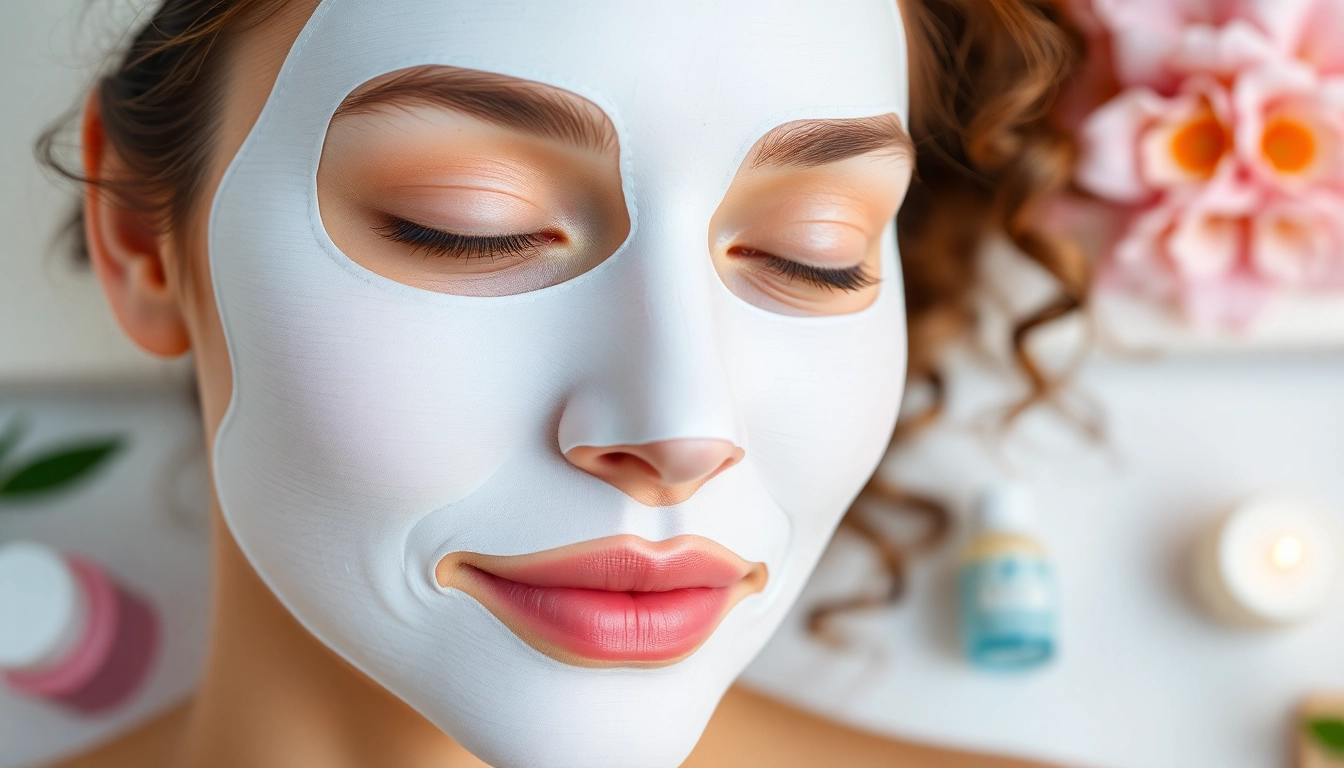Understanding Sheet Masks: A Skincare Essential
In the quest for radiant, healthy skin, skincare enthusiasts have embraced a multitude of products, among which the sheet mask stands out as a formidable ally. Sheet masks are not just a trend; they are an innovative skincare solution that combines convenience with efficacy. As the beauty landscape continues to evolve, understanding the fundamentals of sheet masks can demystify their benefits and help you incorporate them effectively into your regimen.
What is a Sheet Mask?
A sheet mask is a fabric mask that is soaked in a concentrated serum, designed to deliver a burst of hydration, nutrients, and active ingredients to the skin. Typically made from materials such as cotton, bamboo, or hydrogel, these masks mold comfortably to the contours of the face, allowing the serum to penetrate deeply into the skin. The result is a product that offers convenience and a spa-like experience at home.
Common Ingredients Found in Sheet Masks
Sheet masks can contain a wide variety of ingredients, each serving a specific purpose tailored to different skin concerns and types. Some common ingredients include:
- Hyaluronic Acid: Known for its intense hydrating properties, it can hold up to 1000 times its weight in water, making it ideal for dry skin.
- Vitamin C: A powerful antioxidant that brightens the skin, evens out skin tone, and helps combat free radical damage.
- Collagen: A protein that helps maintain skin elasticity and firmness, often found in masks aimed at anti-aging.
- Aloe Vera: Renowned for its soothing properties, it is beneficial for sensitive or irritated skin.
- Tea Tree Oil: A natural antiseptic that helps reduce acne and control oil production for oily skin types.
How Sheet Masks Work on Your Skin
The efficacy of a sheet mask lies in its unique delivery system. When applied, the mask creates an occlusive environment that prevents the serum from evaporating, allowing for maximum absorption. As the ingredients penetrate the skin layers, they can provide hydration, tighten pores, and impart essential nutrients. The result is a visible improvement in skin texture and appearance almost immediately after use.
Benefits of Sheet Masks for Different Skin Types
One of the greatest advantages of sheet masks is their versatility. With formulations catering to various skin concerns, there is likely a sheet mask solution tailored to your specific needs.
Sheet Masks for Dry Skin: Hydration Heroes
For individuals with dry skin, hydration is paramount. Sheet masks designed for dry skin typically feature ingredients like hyaluronic acid, ceramides, and glycerin. These components draw moisture into the skin and create a barrier to lock it in, resulting in supple and hydrated complexions. Regular use can help restore the skin’s moisture balance and combat flakiness.
Oily Skin Solutions: Mattifying Sheet Masks
Those with oily skin often struggle with shine and enlarged pores. Mattifying sheet masks contain ingredients like clay, charcoal, and salicylic acid, which help absorb excess oil and prevent breakouts. These masks can provide immediate relief, reducing shine while keeping the skin hydrated and balanced.
Sensitive Skin: Calming Ingredients to Look For
For sensitive skin, choosing the right sheet mask is crucial to minimize irritation. Look for masks infused with calming agents like aloe vera, chamomile, or calendula. These ingredients reduce redness and soothe inflammation, allowing sensitive skin types to enjoy the benefits of sheet masks without adverse reactions.
How to Incorporate Sheet Masks into Your Routine
Integrating sheet masks into your skincare routine can enhance your overall regimen and yield noticeable improvements to your skin. Here’s a detailed guide on making the most of these effective products.
Step-by-Step Guide on Using a Sheet Mask
- Cleansing: Start with a clean face. Use your favorite cleanser to remove makeup and impurities.
- Toning: Apply a toner to balance the skin’s pH levels, prepping it for maximum absorption of the mask’s ingredients.
- Applying the Mask: Carefully unfold the mask and place it onto your face, aligning it with your eyes, nose, and mouth. Adjust as necessary for comfort.
- Relaxation: Allow the mask to sit for the recommended time, typically 15-20 minutes, and use this time to relax.
- Removing the Mask: Gently peel off the mask and discard it. Avoid rinsing your face afterward; instead, massage any remaining essence into the skin.
When and How Often to Use Sheet Masks
While using sheet masks can be beneficial, the frequency of use can vary depending on your skin type and products in your routine. Generally, using sheet masks 2-3 times a week can yield significant results for hydration and overall skin health. However, those with oily or acne-prone skin may opt for weekly treatments, focusing on mattifying and purifying formulas. Adjust your routine based on how your skin responds, giving it time to absorb the benefits without overloading it with moisture or active ingredients.
Combining Sheet Masks with Other Treatments
Sheet masks can be a complementary addition to other skincare treatments. For example, they can be used post-exfoliation to hydrate and soothe the skin. However, be mindful of layering multiple active ingredients. It’s advisable to avoid using strong acids or retinol immediately before or after a sheet mask, which could lead to sensitivity. Instead, maximize the benefits by using the sheet mask after light exfoliation or regular skincare treatments.
Common Misconceptions About Sheet Masks
Despite the growing popularity of sheet masks, several misconceptions persist regarding their effectiveness and purpose. Let’s take the time to debunk these myths.
Debunking Myths: Do Sheet Masks Really Deliver Results?
A common myth is that sheet masks provide superficial benefits. In reality, while results can be temporary, consistent use can lead to long-term improvements in skin texture, hydration levels, and a more radiant complexion. The key lies in the quality of the ingredients used in the masks.
The Science Behind the Efficacy of Sheet Masks
Numerous studies indicate that the occlusive nature of sheet masks enhances ingredient absorption. Furthermore, the concentrated formulations used in many sheet masks are designed to target specific concerns effectively. This scientific backing illustrates that they are more than a beauty fad; they are a legitimate skincare tool.
Why Sheet Masks Are More Than Just a Trend
Sheet masks have garnered a loyal following not just for their aesthetic appeal but also for their accessibility and versatility. As beauty routines become busier, the simplified application of sheet masks caters to modern lifestyles while delivering spa-like results at home. Their popularity underscores a broader shift in the beauty industry towards self-care and convenience.
Choosing the Right Sheet Mask for Your Needs
With countless options available in the market, selecting the right sheet mask can feel overwhelming. However, by understanding your skin’s unique needs, choosing the perfect match becomes manageable.
Tips for Selecting Sheet Masks Based on Skin Concerns
When browsing for a sheet mask, consider your skin type and specific concerns. Look for masks that address:
- Hydration: For dry skin, masks with hyaluronic acid or aloe vera.
- Acne: Look for items with tea tree oil or charcoal for oil control.
- Anti-Aging: Opt for masks containing collagen or retinol.
- Brightening: Vitamin C-infused masks for evening out tone.
Comparing Popular Brands: What Sets Them Apart
With a plethora of brands offering sheet masks, each has its strengths. For instance, certain brands may focus on organic ingredients, while others might prioritize high-tech formulations. Researching and reading reviews can help you differentiate effective products from gimmicks, allowing you to make informed choices based on real user experiences.
DIY Sheet Masks: Are They Effective?
Diving into the world of DIY sheet masks can be an exciting venture for those who prefer customization. Using natural ingredients like honey, avocado, or green tea, you can create your own masks tailored to your skin’s needs. However, ensure that the base fabric is appropriate for holding liquids and allowing penetration without overdripping. While DIY masks can be fun and effective, monitoring for skin reactions is crucial, especially if you use unfamiliar ingredients.



